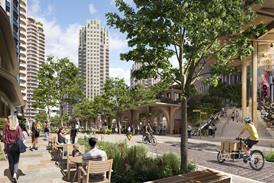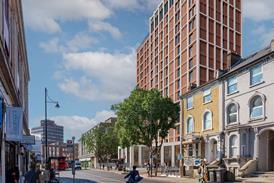Building Design’s housing columnist Julia Park considers what architects and policymakers should learn from the coronavirus crisis about housing design

Writing in the Sunday Times this month, journalist Hugh Graham observed that social distancing is needed inside the home as well outside, as the limitations of open-plan living suddenly become apparent. These are, we hope, extraordinary times and we’ll need a period of reflection before making long-lasting changes to our way of life, but covid-19’s lasting legacies will surely include a re-evaluation of how we live, work and interact with those around us.
Home has possibly never been more important: in the literal sense, it is now our “safe haven”. But how well is it coping with the huge range of activities that we undertake every day – including those which usually take place elsewhere?
The fact that families, and other co-habitees, need spaces to come together and spaces to be apart, was one of the founding principles of the London Housing Design Guide. It led to reasonably generous minimum sizes for bedrooms and living/dining/kitchen spaces and more storage than had typically been provided before.

Those who still resent the fact that all double and twin bedrooms have to be at least 11.5sq m, that every bedroom has to accommodate a desk and that homes with three or more bedrooms need two social spaces, aren’t grumbling as loudly now. None of these requirements were conceived with a life-limiting pandemic in mind and nor did they imply that every bedroom should be furnished in the same way,. It was simply about ensuring that all new homes were fit for purpose when fully occupied and allowed rooms to be used flexibly – for work, rest and play.
The original guide also required the glazing to each habitable room to be at least 20% of its floor area and sunlight to enter at least one habitable room for part of the day. Dual aspect became more or less mandatory – for cross-ventilation, to provide a choice of outlook and the prospect of a quieter side with cleaner air. Every home had to have some private space; at least a balcony of 5sq m.

These standards felt sensible at the time and feel even more sensible now. Most have survived, but some have been watered down over the last 10 years. Some were formally banned under the housing standards review of 2015 and others are being waived by planners in pursuit of numbers. Single-aspect apartments have returned in the form of huge, institutional, build-to-rent developments where long double-banked corridors are designed for easy cleaning rather than for meeting neighbours, and balconies have become optional. Larger families aren’t getting two social spaces any more, studios are endemic and daylight, ventilation and air quality frequently compromised.
Right now, we just want life to revert to normal. But in many ways, normal hasn’t been good enough for a long time
Right now, we just want life to revert to normal. But in many ways, normal hasn’t been good enough for a long time. Housing is a case in point; particularly for the thousands of older and disabled people who already spend large amounts of time at home, often from necessity not choice. City living has always been challenging for families, but it must be desperately difficult for single parents trapped in temporary accommodation. London’s standards won’t prevent another pandemic, but they remain a sensible, humane baseline that offers reliable sanctity, the flexibility to accommodate change, and some resilience against the unexpected
Having experienced home-working, many office workers (including architects) will, I think, be reluctant to go back to the 40+ hour week in the office. Anecdotal feedback from a quick, “How’s it going so far?” survey of my colleagues reveals that they are working everywhere from the kitchen, sitting room or a bedroom, to under the stairs. They seem to be coping well. Computers don’t take up much space but a good connection and a good chair are proving essential and, understandably, noise is an issue for those with young children.
But everyone agrees that there are pros and cons to working from home. Avoiding the long, tiring and expensive commute, more flexible working hours, better lunches and more family time are the most frequently mentioned benefits, but most are also feeling a degree of isolation and missing the day-to-day interaction and close collaboration. It would be strange if they weren’t. Homeworking requires a particular kind of self-discipline and, overall, I’m really impressed by the way my colleagues seem to be adapting.
Across the country and across the world many people will be thinking about their work/life balance. My guess is that working from home for a couple of days a week will soon become the norm for many office workers. I think we’ll also become more attuned to our mental and physical health, when and how we interact with others, and what really matters to us. While nothing will ever be a complete substitute for face-to-face interaction, most of the meetings we do could easily be virtual and save a huge amount of travel time and fossil fuel. We should all be more discerning about what we do, where we do it and why.
What does this imply for our homes? The Sunday Times article notes that 63% of the homes built since 2003 have open-plan living/dining spaces and that many families are now regretting their choice. Architects offer some expedient tips: moving furniture to create zones with distinct characters and uses is the main one – useful to a point but a bit subtle for children and hopeless for simultaneous Skype meetings. Sales of noise-cancelling headphones have apparently soared.
>> Also read: Coronavirus: What next for architecture?
Sliding walls and doors are a better solution but not cheap and not practical right now. I’ve always enjoyed exploring a range of different layouts for the homes I design; mindful that family life evolves, and that open plan is great until it isn’t (soundproof doors are sometimes the only way to survive family life…). I recommend starting with a workable cellular layout and taking walls away. It forces you to have more windows and it’s invariably much harder to turn an open-plan space into separate rooms. Perhaps we should also be binding the alternative layouts into sales details and title deeds to make successive occupants aware of the possibilities?
Many of my colleagues mentioned windows – not just for the obvious benefits of daylight and sunlight but also their ability to connect us to the wider world and remind us we’re not alone. In fact, windows seem to be second only to outdoor space in the what-really-matters-list. This is further evidence that our wellbeing, and mental health in particular, needs to be taken more seriously, and that mostly it doesn’t require anything new or complicated; it simply means doing things better.
I would start with a ban on trussed rafters (every roof full of timber is a missed opportunity for a workplace or hobbies room) and studio flats (no one wants to look at their bed or their workspace all day). I’d insist on at least two habitable rooms and make private open space mandatory – no one’s going to force you to use it after all… I’d increase storage capacity, particularly in the kitchen, and improve soundproofing between rooms and dwellings. I’ll think even harder about how it will feel to live in each home I design and focus even more on the special touches that bring everyday enjoyment and lift our spirits when, as now, the world falters.
Postscript
Julia Park is head of housing research at Levitt Bernstein
















3 Readers' comments